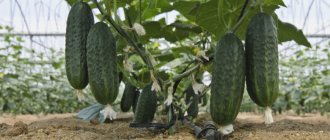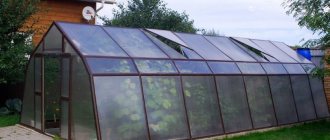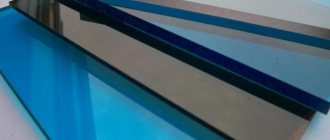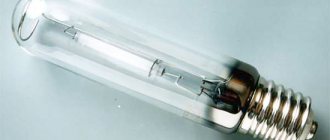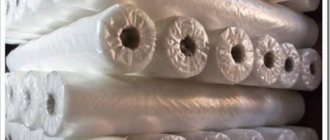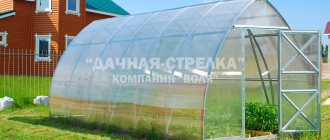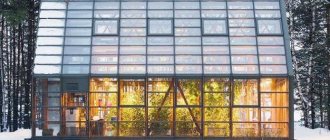For quite a long time, polyethylene film remained the most budget-friendly covering material. However, then its popularity fell due to its short service life, low strength, and low insulating ability.
Manufacturers have offered films for greenhouses of completely different types with good light transmittance, insulating properties, and capable of withstanding significant stretching and tensile loads. From all the new materials, you can choose the optimal one both in price and quality.
No. 1. Advantages and disadvantages of greenhouse film
Previously, only plastic film was used to cover greenhouses. At the moment, summer residents are offered more advanced analogues, in which some of the disadvantages are less pronounced. In general, all types of films that are used to equip greenhouses and greenhouses are characterized by common pros and cons.
Main advantages:
- low price. There are price differences between different types of film, but compared to glass and polycarbonate it is still a budget option;
- high elasticity and plasticity, so with the help of film you can equip a greenhouse of any shape;
- moisture resistance;
- high level of light transmission and ability to diffuse sunlight;
- low weight and easy installation.
Main disadvantages:
- low durability. When choosing plastic film, you should be prepared that it will need to be changed next season. More expensive analogues will have to be replaced after 2-3 seasons;
- low resistance to sunlight, which leads to rapid destruction of the material, but in some films this disadvantage is not so pronounced;
- Condensation accumulates on the surface of the film, which is harmful to most crops grown in the heifer. This drawback was avoided by hydrophilic films, in the production of which special additives are used;
- accumulation of electrostatic charge, which helps attract dust, and this, in turn, reduces transparency. Manufacturers are also trying to combat this disadvantage by introducing special additives.
Many summer residents also complain that the film stretches and sag, so they have to constantly tighten it. But the presence of so many significant disadvantages still does not make the material less popular, because this is the cheapest way to equip a greenhouse in the country, and many believe that it is more profitable to change the coating once a year than to immediately spend money on buying expensive polycarbonate.
Air bubble materials
Bubble film, widely used in packaging, can provide reliable protection for plants from cold and wind. This material is made from high-density polyethylene, so it is not elastic, but strong and durable. Unlike thinner films, the air-bubble type is not afraid of mechanical damage, it does not come apart after a break and can be quickly restored. Each bubble is a separate chamber with air, so if damaged, the entire fabric retains its properties.
On a note! The smaller the chambers, the more convenient it is to use the canvas for covering.
Bubble covering materials are excellent for installation on metal and wooden frames, for covering large areas. They cope well with wind and even snow loads, since they have a high strength index. The bubbles do not focus the light, so the plants do not get burned. But this shape of the surface makes it difficult for condensation to roll off, so it can flow onto the leaves, which is unacceptable for a number of greenhouse crops.
Read also: Assembling greenhouses from arcs Greenhouses assembled from arcs and sheets of covering material have become widespread in almost all...
This material can be secured using special plugs and latches, or using regular glazing beads. You cannot stretch it; on the contrary, it is recommended to leave it a little loose to increase its resistance to wind. Bubble wrap should be stored on a roll. It is not toxic to the environment, but it does not decompose, so it should not be thrown away.
The production of bubble film is a costly process; some manufacturers save on changing the ratio of additives to the base material and include secondary raw materials in the polymer mixture. Such films should cost much less, so when purchasing, you should carefully study the composition. Covering sheets based on recycled products transmit light much worse.
No. 3. Polyethylene film
The main advantage is low cost . The film transmits about 80% of thermal radiation, so daytime heat is poorly retained at night. Properly installed high-quality polyethylene film will last no more than a season , and is unlikely to survive the winter, since temperature changes, wind and snow will destroy the material. Even the thickest films are not particularly durable.
Polyethylene film is very delicate , so it must be transported and installed very carefully. Even the smallest cut will soon “grow”, which will negate all efforts to arrange the greenhouse.
The material is sold in rolls 1.2-3 m wide; it can be a single-layer fabric or a sleeve. In the second case, the material can be cut along the seam and a wider sheet can be obtained, or you can cover the greenhouse with a sleeve, although you should not count on a significant increase in durability. The bend of the sleeve is considered the weakest point and is destroyed first, so it is better to immediately strengthen it with tape.
Tips on how to extend the life of the film
Proper installation, as well as careful handling can significantly extend the service life of the coating material.
We recommend that you read about how to make a vegetarian greenhouse with your own hands.
In particular, experts advise adhering to simple but important rules:
- protect the material from mechanical damage, scratches, tears, especially when performing installation work;
- ensure that the greenhouse frame does not have sharp corners and has as smooth a surface as possible;
- the greenhouse must be treated with an antiseptic, which reduces the risk of fungi and mold that negatively affect the condition of the film;
- It is recommended to install the covering fabric at temperatures of +5...+15°C;
- installation must be carried out in such a way as to prevent sagging of the material, since under the influence of even a slight wind, sagging cellophane easily breaks;
- It is prohibited to install the fold of the film on the “ridge” of the structure.
If the covering material is not highly durable and durable, then it is recommended to remove it from the greenhouse for the winter. A greenhouse or greenhouse helps gardeners grow vegetables all year round, which can easily be installed independently using available materials. The simplest, most economical and lightweight option is a film structure, high-quality material for which is available in any hardware store.
No. 4. Reinforced film
Reinforced film differs from ordinary polyethylene film by the presence of a unique frame made of fiberglass, pressed, twisted or stretched polyethylene or polypropylene, the thickness of the frame threads is 0.29-0.32 mm. Polyethylene, as a rule, is used more durable, sometimes with additives for greater resistance to sunlight. The main load is borne by the frame, so a greenhouse with such a coating becomes resistant to wind, snow and even hail. The film can protect seedlings even in frosts down to -50C.
The material will last in the greenhouse for more than a year, usually it lasts for three seasons , but some manufacturers talk about a service life of 5 or even 7 years, but much depends on the characteristics of the film and the climatic conditions of the region. Reinforced film is more repairable : holes can be sealed with tape, they do not tend to spread to the entire canvas. The main characteristic of the material is not thickness, but density. The most common material is considered to be with a density of 120-200 g/m2. There is a film on sale with holes in the cells, which provides the greenhouse with proper tightness, but does not allow the air to be “preserved” in it.
The durability and strength of reinforced film comes at a higher price . In addition, the light transmission of this material is slightly lower than that of a conventional stabilized film, and dust is very difficult to wash off due to the relief, which also harms transparency.
Film from Dirs Stroy LLC
produces and sells reinforced and polyethylene films of different densities and sizes. All standards are observed in production, strict quality control is carried out, and high-quality and safe raw materials are used. All products are accompanied by quality certificates, and since production is located in the Moscow region, product prices are more favorable than those of many competitors. You can get acquainted with the products and terms of purchase on the company’s website.
Film coating properties
At the stage of choosing a film covering for greenhouses, many people wonder what a high-quality film should be.
According to generally accepted building codes, greenhouse coatings must have the following qualities:
- excellent wind resistance;
- light scattering ability;
- breathability, the ability to allow oxygen and carbon dioxide to pass through well;
- ability to retain heat well;
- high elasticity rates;
- high resistance to atmospheric conditions;
- excellent tear strength;
- antistatic qualities;
- long service life.
In addition to the above qualities, the material must be as durable as possible and prevent sagging and drop formation.
Did you know? Every year, over 1 trillion plastic bags are sold worldwide. In this case, the decomposition period of the material is 1000 years. The first to refuse to use this packaging was the American island of Hawaii.
No. 5. PVC films for greenhouses
Polyvinyl chloride films are one of the best options for arranging greenhouses. This is an elastic and durable material that can last from 2-3 seasons to 6-7 depending on operating conditions, care and climate. As a rule, light-converting and stabilizing additives are added to the composition.
The material transmits up to 90% of light, 80% of ultraviolet radiation and blocks up to 95% of infrared radiation, which means that at night and during frosts the greenhouse will be warmer than in the same one made of plastic film. This is a very significant advantage of the material.
The disadvantage of the material is the price, which is 2-3 times higher than the cost of the polyethylene analogue, but taking into account the fact that there is no need to buy a new film and install it every season, this disadvantage cannot be called too significant. Another nuance - polyvinyl chloride strongly attracts dust , but it is also easy to wash off. The frost resistance of the material is low; at temperatures below -150C the film becomes too fragile, so heating will be mandatory for winter greenhouses.
Copolymer ethylene vinyl acetate
Copolymer ethylene vinyl acetate film
A high-tech material, it is especially durable and at the same time elastic, transmits up to 92% of the visible part of the spectrum, retains heat well, and is hydrophilic. Condensation on the inside of such a film forms in a continuous, even layer. The copolymer film is resistant to frost, withstands strong wind loads and is not afraid of punctures. The only drawback is the high permeability to sunlight, so on a hot and sunny day such a greenhouse can simply overheat. But this film wears out for 3 long years.
No. 6. Polyethylene films with special additives
If you introduce specific substances into polyethylene, you can slightly improve its performance. Depending on the additives, the following types of material are distinguished:
- Stabilized film is produced with the addition of substances that increase resistance to sunlight . The service life increases by 2-3 times, and the price also increases. The material may have an orange or pinkish tint, but this is not necessary. Externally, stabilized and regular polyethylene films are the same, so you need to carefully look at the packaging and labeling;
- light converting film “knows how” to convert hard ultraviolet radiation, harmful to plants, into infrared and red radiation, which increase productivity. All this is possible thanks to the phosphor additive, but in order for the material to last for a long time, it is necessary that the composition also contains stabilizing substances. To make sure that you really have a light-converting film in front of you, you need to shine it with an ultraviolet lamp, and the light from the lamp should change to red;
- heat retaining film has a matte whitish tint. It weakly transmits thermal radiation, so the temperature in the greenhouse will be 1-30C higher than in similar other types of film. Due to this, early harvests can be increased by 10-30%, saving on heating costs. The service life of the film is about 9 months, the material has antistatic and hydrophilic properties;
- stabilized hydrophilic film allows you to solve the “drop” problem characteristic of other types of material. Flat-drip condensate forms on this film in the form of a continuous layer, so there is no negative effect on plants. Light transmission is high, the ability to transmit thermal radiation is 30-35%, so it will be warm in such greenhouses;
- bubble wrap strongly resembles the one used to package fragile goods. It has good light transmission, and the level of thermal insulation is comparable to polycarbonate. The strength is low, with the exception of special types of film, but the material is suitable for growing early crops in a small greenhouse;
- foamed film consists of a monolithic and foamed layer of polyethylene, transmits 70% of light, retains heat well, and is suitable for the construction of greenhouses intended for vegetative propagation of plants;
- copolymer ethylene vinyl acetate has a decent level of strength, retains heat well, it is resistant to punctures, wind loads, frost, and hydrophilic. High light transmittance (up to 92%) can cause overheating on hot summer days. Durability – up to 3 years;
- Photodestructible film is destroyed after a certain period of time (20, 45 and 60 days). Used for frameless shelters and mulching.
Despite the stated service life, some experts recommend changing the film every three years, as it still becomes cloudy. If the material has retained its integrity, it can be used for other purposes.
You can also find films in the production of which several additives were used at once - this is the best option. But often, ordinary polyethylene films are issued under the guise of special films, so it doesn’t hurt to look at the certificates and markings.
According to GOST 10354-82, stabilized film for greenhouses and hotbeds is marked ST, stabilized light-converting film – SIC. You can also use film for greenhouses, which is marked with the letter H: this is a stabilized or unstabilized film for the manufacture of household products.
Basic Rules
In order for the greenhouse to serve for a long time, you first need to decide whether it will be a winter one, capable of protecting against frost and frost, or will be used in the warmer seasons. This will allow you to choose the right covering material for it. Then the material is calculated and some features of its fastening are taken into account.
Calculation of materials
The amount of film that will be needed to cover the frame of the greenhouse can be easily calculated if the width of the film roll and the length of the frame are known. The value corresponding to the dimensions of the frame is divided by the width of the covering material. The resulting number will display the number of canvases. Here we must remember that the canvases are overlapped.
If the greenhouse has an arched structure, then the length of the canvas will be equal to the length of the arc. If the structure has a pitched roof, then the lengths of all sides of the structure in cross section are summed up, and 10% is added to this value for fastening the material around the perimeter.
Important! Standard film roll width
-
150 cm. In this roll, the material can be double, that is, it is a sleeve that is cut along the bend.
To find out how many meters of film are needed to cover a greenhouse, you need to multiply the number of sheets by their length. To this value should be added the amount of film required to cover the ends of the structure. To do this, their area is calculated.
Principles of film greenhouse construction
A greenhouse is a protective shelter used for growing early seedlings of garden crops and then planting them in open soil. The principle of its operation is simple: it absorbs thermal radiation coming from the outside and turns it into heat.
In addition, the greenhouse can also retain this heat. As a result, a certain temperature is always maintained inside it. Also, such a shelter protects crops from the outside world, preventing insects and unfavorable atmospheric phenomena from getting inside.
But in order for the greenhouse to perform its direct functions, it is necessary to follow some rules for the construction of its top (cover):
- To accurately cut the covering material, it is better to throw the roll over the frame, stretch it and cut it, after adding another 20–25 cm for fastening.
- The cut strips need to be folded overlapping on a flat surface and secured with tape on the inside.
- When cutting out the covering for the ends, be sure to leave an allowance. Doors and windows are cut separately and with a margin.
- You need to attach the film at a moderate temperature and on a windless day - this way it will not sag or sway too much during operation.
- It is advisable to cover the greenhouse with covering material only before planting the plants - this way the structure will last longer.
Did you know? The largest greenhouse complex is located in Almeria (province of Spain).
No. 7. Film density and thickness
The denser and thicker the film, the better it will cope with negative environmental factors. In the case of conventional polyethylene film, thickness has little effect on durability, but when it comes to stabilized materials, this factor is more important.
Externally, it is impossible to distinguish between films with a thickness of 200 and 100 microns , which is what unscrupulous sellers take advantage of. To protect yourself from a bad purchase, it is worth remembering that a thicker film weighs more: a linear meter of 200 micron film weighs 530 g , 150 microns - 400 g, 120 microns - 320 g, 100 microns - 260 g and 80 microns - 210 g. For greenhouses, it is better to choose a film with a thickness of 150-200 microns.
No. 8. Film color
It is better to choose a transparent film - it lets in more light. To obtain material of different shades, food coloring is usually added to the composition, which tends to fade under the rays of the sun, so there is no point in it. If the paint is persistent, then less light will penetrate into the greenhouse, which will lead to a decrease in yields and the need to use additional lighting.
Basic methods of film attachment
The main task of the fastener is reliable fixation of the film and ease of use. Here are examples of the most common methods of attaching covering material.
Clamps, clips
This type of fastening is used if the frame is made of PVC pipes and fittings. It allows you to firmly fix the film without nails. Clamps can be purchased at the store or made independently. To do this, the plastic pipe is cut into pieces of any length (5–20 cm).
The side of this pipe is cut out. The edges must be processed so that they cannot tear the covering material. If you use a purchased metal clip, then you must place heat-insulating material under it so that the metal heated in the sun does not melt the film.
Reiki
This fastening method involves the use of a wooden strip and fasteners (nails, self-tapping screws). During fastening, damage to the covering material occurs, which shortens its service life.
Also learn how to properly plant peppers in a greenhouse.
For a wooden frame
10 cm long bars are cut, carefully processed and, for greater reliability, wrapped in several layers of polyethylene film, the first layer of which is fixed to a wooden base with rubber glue. The slats are placed over the covering on the frame posts and fixed with nails or self-tapping screws.
To the metal frame
In this case, the lath, prepared in the manner described above, is attached over the covering material on the sides of the greenhouse to the metal frame posts.


